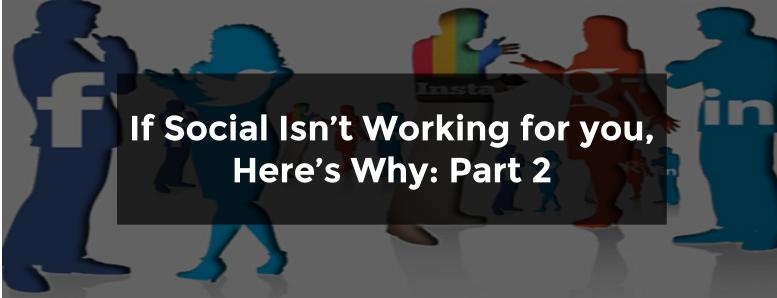
“Implementing a successful social media strategy isn’t that hard.”
That’s what they all say.
As marketers we know that’s not true at all. If your social strategy isn’t bringing you hoards of new customers and getting fans engaging with your platforms, you’re not alone.
It turns out a social strategy is never actually as easy as it sounds.
Now that you’ve read part 1 of my social media strategy audit, it’s time for part 2, presenting you with 3 more reasons your social strategy isn’t working for your business.
Without further ado let’s dig in and see where your fault lines lie.
Your Content’s Not Dynamic
To get fans or followers pumped about your content and sharing your posts, that content needs to excite your audience (this isn’t news to you…). But it can be easy to forget that not every audience is created equal. You need to constantly be adapting and changing to the needs of your changing audience on each network.
If your social strategy involves posting the same kind of blog articles on each of your platforms every morning, you’re definitely not optimizing your social efforts.
People use different platforms for different purposes, so you need to know the types of content each platform’s audience would enjoy the most.
Facebook, for example, is a great place to share photos or videos and its autoplay feature makes your content more likely to grab the attention of users. Google+, on the other hand, is where you can present some stats or interesting excerpts from your articles or ebooks to lure in potential readers.
It’s possible your content is also not engaging. I know, the word tends to get thrown around too often. But what does it actually mean to have engaging content?
- Content which creates controversy (so long as you’ve backed up your assertions)
- Content which discusses a brand new concept or idea
- Content which addresses news and current events, and how they impact your readers
- Content created with context and personality, ensuring your readers can differentiate you from your competitors
How to Post Engaging Content in Engaging Ways:
- Try out a variety of post types that will capture the attention of your social media followers.
- Intriguing photos which grab the eye and tie into your content
- Fill in the blanks related to your content
- Intriguing stats to inform your audience
- Quotes
Aside from posting great content, it’s also more engaging to your audience if you interact back with them, responding to their social comments or questions and putting yourself out there.
Make your social channels a two-way interaction and have real conversations with your followers. An example of this can be seen below from the beauty brand Sephora:

They make sure to respond to every question on their social channels with the best possible answer for that Fan. The replies range from answering simple questions about store locations or how to use specific products, to responding to individuals who are unsatisfied with a Sephora product.
Even if you receive a negative comment on a post, use your social channels to build social relationships. Respond honestly and openly in a personable tone to make them want to remain a loyal customer or fan.
You’re Not Tracking Your Social Posts
To be completely honest, your social strategy can’t succeed if you aren’t tracking which posts and networks are providing your business with the best value.
By not tracking where your traffic and conversions are coming from you could be missing out on massive opportunities (or wasting budget you could be using elsewhere).
What if you’re spending hours on platforms that gets you exactly zero dollars in return?
If you’re not tracking every step of your social game, you’re missing an essential component of your strategy.
Our business has actually recently adjusted to placing more time and effort into tracking the return we are getting from each of our social networks including Facebook, Twitter, Google+, LinkedIn and Quora.
So how does tracking affect your strategy?
First and foremost tracking helps you measure your social engagement. This is obviously a necessary component of determining which post styles and pieces of content elicit the highest ratio of interaction.
But more than that, tracking gives you the inside scoop on which platforms are bringing traffic to your website, your blog, your pricing page, etc (and whether or not that traffic is signing up). It tells you exactly which platforms you should be spending the majority of your time and resources on.
Each major social platform whether it be Facebook, Twitter or LinkedIn has its own analytics which tells you in detail which of your posts are getting the most exposure or engagement. You should always record your posts’ comments, likes and shares but also the number of clicks. This allows you to see what your audience wants so you can provide them with content they will truly love.
But, aside from tracking each network independently, you also need to be using Google Analytics to compare the social networks to each other. By being able to compare all of the platforms in one spot you can see where your value lies and how you should be dividing up your scheduled social time.
A UTM code is the best way to monitor where you are getting your website traffic from, and if that traffic is converting in the long run.
A UTM code is simply a code you can attach to your URL to track a traffic source, showing you where visitors came from and what campaign source (Facebook, Twitter, etc) got them to your site. Using Google’s URL builder you can enter your URL and campaign. When a user clicks your custom link on a social platform (or email mailout) the parameters are sent to your Google Analytics, showing you which of those sources is the most effective in drawing in users.
Tracking is actually a two-tiered aspect of your social strategy. You need to be looking at each platform’s internal posts and what gets the most reaction, but also comparing the platforms to one another. Doing one without the other means you’re holding back your social strategy from reaching its potential.
You’re Not Scheduling Your Posts
At times it can feel impossible to stay up to date and active on your social platforms all the time.
Whether you have one social platform or five, scheduling will save your coworkers from witnessing yet another swearing and hair-pulling social media meltdown.
What are the benefits of using a scheduling tool (like Hootsuite or Buffer)?
- You can work more efficiently, blocking off time to create all of your posts for a day or two at once. It’s much easier to schedule a number of posts while your head is in the social mindset than trying to create posts on the fly throughout the day. And trust me, your posts will also be noticeably more creative and effective.
- You can create a consistent schedule. From looking at your analytics (which we all know is crucial by now) you can see when your audience engages most with your posts on your platforms and schedule accordingly each day. We all have those days where everything we see is relevant and worthy of a post. Scheduling allows you to spread out all of these ideas so you don’t overwhelm followers with 12 posts one day and 2 the next.
- You can connect with users at any time of the day. If you have followers and fans around the world, your social platforms can’t be sleeping while you are. Scheduling lets you work 24/7, getting your content into the hands that matter at the right times.
- You can actually take a day off. You heard me. Weekends, as it turns out, can be pretty fun. With a scheduling tool you can take a couple hours off and know that your platforms are still working for you, even though you aren’t staring at your phone or computer screen.
Believe me yet? Scheduling can be your best friend.
That doesn’t mean you can’t have spur of the moment posts too. If something grabs your attention and needs to be seen immediately then by all means hit the “Post now” button. A blend of scheduled and live updates is the optimal strategy.
It also doesn’t mean that you can turn off your phone’s social notifications. If someone has posted a complaint on your Facebook wall, scheduling isn’t going to solve that problem.
Scheduling is just one more way to step up your social game, allowing you to be organized and optimized.
Conclusion
Social media is no longer just a buzz builder. It’s a fully developed strategy that requires time and effort to be nurtured to success. So even if your social game isn’t as strong as it should be, don’t give up. With the right attention and love your social can generate true return for your business.
Have you had frustration or success with your recent social efforts? What are you doing to counter Facebook’s fall in organic reach? Are there any platforms you love, or love to hate? Get social in the comment section below!
– Written by Claire Grayston
Claire is a digital content marketer at Wishpond. When not racking her brain for new content, you’ll find her hiking or snowboarding the local mountains.
